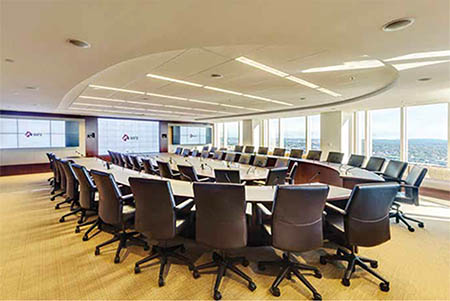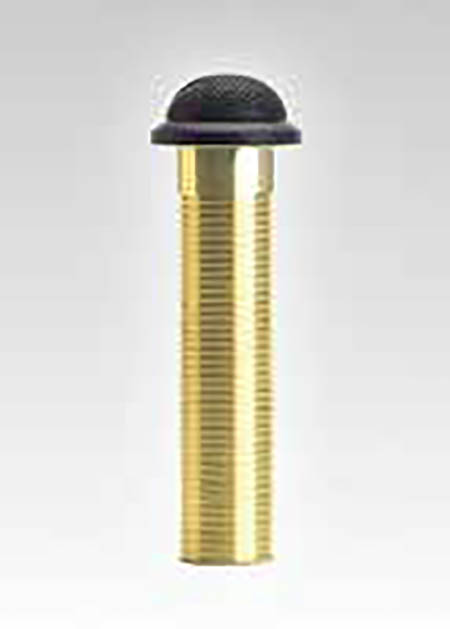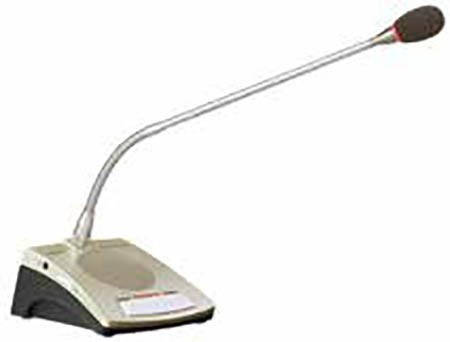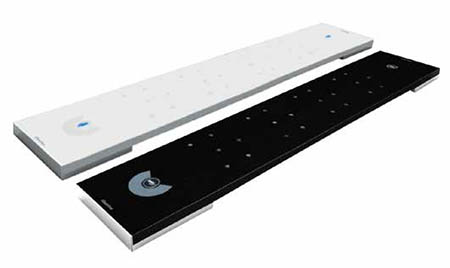Top Five Conference Room Mic Myths

When a meeting is large enough that not everyone is able to hear all potential talkers in the room, you need to turn to sound reinforcement or audio conferencing technologies. If the meeting participants are limited to only those physically present in the same room, the objective is simple: to increase the audio level of each talker within the boundaries of the room. Achieving this requires some sort of sound reinforcement system, and the main challenges are acoustical.
If the meeting includes remote participants, the objective is a little more complicated: to pick up the sound of each talker and also electronically deliver the signal to a remote location. Execution is further complicated by the fact that visual cues are either non-existent (audio conferencing) or limited (video conferencing).
In any conferencing or group meeting situation, we rely on some sort of microphone to act as an “electronic ear” to capture each talker. Although technology is getting closer all the time, there still exists no complementary electronic brain to process sound exactly like the human brain. It’s up to the conference room microphone (or microphones) to do the heavy lifting—in most cases, at least. How well these mics do the job of simulating ear/brain audio processing depends on the specific type you choose, and how they’re used in actual application. The range of types of mics and the many ways in which they’re used (or misused) has led to many myths. Here are five of them.
1. One mic is enough to pick up all talkers in a room.

Because mics are dumb (in both the literal and figurative sense), they can’t know who is talking at any given moment. They can’t possibly adjust their own level for loud talkers versus quiet talkers, without additional signal processing. And they can’t see where are all of the participants are sitting around the conference table. Even with electronic assistance in the form of compression/limiting or automatic gain control, a single microphone attempting to hear many talkers will adjust to the loudest talker at a given moment, so picking up the speech of simultaneous talkers with the ability to discriminate between them is virtually impossible. In addition to the level inconsistencies, a single mic will pick up more “room noise” and reverberation as it tries to pick up the more distant talkers. Beware of technical literature that claims a “pick-up range” of many feet. The fact is, any microphone will pick up voices at great distances; but as the gain increases, it will also pick up extraneous sound and room reflections, which degrade the intelligibility of intended speech. It’s better to use more microphones, with no talker more than four to five feet from a mic element.
2. You have to speak directly into the mic at close range, or it won’t pick up your voice at all.

The M3 tri-element ceiling microphone from Audix features three condenser mic capsules in a small (2 in/50 mm diameter) housing that hangs from the ceiling. The M3 is optimized for speech frequencies. Call this the rock star (or celebrity) effect. Everyone’s seen a stage performer devouring the mic capsule, in attempt to increase the gain of their own voice over the rest of the band. Or an acceptance speech on an awards broadcast where for some reason a celebrity awkwardly leans down too closely to a microphone that’s intentionally lowered to minimize visual intrusion. In both cases, the sound engineer must adjust levels to minimize distortion and regain balance of the overall sound. It’s not the right way to use a microphone on stage or in the conference room, so don’t mimic this behavior.
A daily selection of features, industry news, and analysis for tech managers. Sign up below.
Conference room mics are not like live stage mics, and there is no sound engineer to compensate for this misuse. Although speaking “on” the mic is the most effective way to minimize the pickup of sound other than your voice, it also means it won’t pick up anyone else. And you’re almost certain to electronically overload the microphone input, causing distortion and poor speech intelligibility.
3. Use only gooseneck microphones.

The Revolabs’ “wearable” mic Goosenecks microphones do an excellent job of putting the microphone close to the mouth of the talker, but using them also means that every potential talker will need their own individual microphone. The truth is, a separate mic for each talker is probably the most effective way to “mic” (as a verb) a conference room. That’s why it is the most common method used in “mission critical” or high level conference sessions. But it can also be a fairly complicated and expensive proposition–in addition to the cost of multiple microphones, the system will require extensive cabling and some sort of mixer (automatic or manually controlled).
For smaller meetings and conferences, other options will work effectively too. A smaller number of properly located tabletops mics (surface mounted or boundary types) will provide sufficient coverage in most cases. But since their pick-up area is likely to be much larger, they’ll also pick up ambient sound and present feedback problems if a local sound reinforcement system is being used.
4. Ceiling mics pick up too much unwanted sound.

Low-profile boundary mics like Shure’s MX395 (which measures 1.25 in/38 mm in diameter) become unobtrusive when installed in a conference table, and are available in three pick-up patterns (cardioid, omnidirectional, and bi-directional). The use of ceiling mics is a much-debated topic in the world of AV system integration. The term “ceiling mic” itself should probably be eliminated, since it’s hard to imagine any reason for needing to “mic the ceiling.” It’s become such an issue that one well-known IT consultant has publicly joked that the purpose of a ceiling microphone is to “pick up all the sounds that the air vents produce.”
There’s no question that mounting the mic on the ceiling puts it conveniently well out of the way of rustling papers, coffee cups, and the myriad laptops occupying the tabletops in most conference rooms. The problem comes back to the fact that a brainless microphone has no idea which sounds are talkers, or which talkers should be picked up at any given time, or which sound is coming from a nearby air vent or ceiling mounted projector. But this myth has been busted by at least two manufacturers. “Steerable” or “beamforming” microphones use the natural interference effects of sound waves to selectively alter the pick-up pattern of a microphone array. It’s the same principal (in reverse) used by many loudspeaker manufacturers to control directivity and sound projection. The phenomenon requires multiple transducers (microphone elements or loudspeakers) and signal processing, so it can be a more expensive alternative, but it does work quite effectively in some cases. Acting as a primitive brain for the microphone array, the signal processing activates specific individual microphone elements which interact to direct the sound pick-up pattern in the desired direction–away from unwanted sound sources, and toward the talker(s).
5. You have to remain in one place while talking into a conference room mic.
In a business presentation or class lecture, sometimes it’s impossible to keep the presenter in one place. And obviously, microphones can’t follow the talker if they happen to be moving about the room. Or can they? There are two flaws in this myth.
Microphones can be worn. Wireless lavalier mics have been around for years, and they’re an excellent solution to this problem. But the traditional lav mic requires a bulky transmitter pack, dealing with the possibility of dead batteries, and the embarrassing “oops, I forgot the mic was on” moment when the presenter leaves the building or steps out to the restroom.
For conference applications, an even better solution is the clip-on, “wearable” wireless form factor popularized by manufacturers like Sudbury, MA-based manufacturer Revolabs. Each presenter can have their own wearable mic element, which is small enough to be unobtrusive but large enough to not forget you’re wearing it. When not in use, the mics are returned to the charger base for battery re-charging and storage.
As for the second flaw in this myth, it turns out that microphones can, in fact, find the talker in the room, and “follow” them around–sort of. Using an extension of the intelligent digital signal processing used to steer the pick-up pattern of a mic, it’s also possible to automatically and sonically track (follow) the sound source to its physical location in the room.
But as intelligent as the signal processing is, it still can’t compare to the human brain and visual tracking. Since it tracks to the loudest sound source at any given moment, it can’t (for example) remain focused on “Joe’s” voice if “Susan” suddenly starts talking more loudly than Joe.
Excellent results for any conference application can be achieved as long as the correct type of microphone is selected and it is properly used. Getting beyond the many application myths starts by realizing—and accepting—that no mic/signal processing combination is a match for the human ear/brain.
Mark R. Mayfield has an extensive background as a recording/live sound engineer and AV products marketing executive. He is a regular contributor to InfoComm All Voices and AV Technology magazine.
New System for Digital Audio Recording


Intended for small to medium-sized conference rooms, TAIDEN ’s HCS-3900 series is a fully digital conference system providing enhanced audio performance, audio recording, and control capabilities through a user-friendly interface. The central control unit is designed to be directly placed in the meeting space, instead of an equipment rack. A USB interface and an SD card slots are available on the unit for audio recording and playback. If one of these devices is full, the recording will automatically switch to the other device without interruption. Similar to all TAIDEN product lines, individual gain control is available for each microphone. Additional control capabilities such as requests to speak lists, attendee’s name assignments or automatic video tracking, will be available via web control. Users will be able to access the IP address of the main unit from a web browser to handle meeting management. Visit www.mediavision.com for more information.
Beamforming

ClearOne’s Beamforming Mic Array features 24 microphone elements in a sleek rectangular form factor that can be mounted on the ceiling, a wall, or tabletop. Its beamforming and adaptive steering technologies enable “auto voice tracking”, which find the talker and track them around the room. The mic also features ClearOne’s nextgeneration Acoustic Echo Cancellation (AEC) and works with the company’s Converge Pro products. Up to three arrays can be attached to each Converge Pro system, and as many as 16 arrays (along with six required Converge Pro systems) can be networked together to provide coverage in multiple rooms or zones within a building. Available in black or white.
Biamp Systems Launches VoIP Certification Training Program

Biamp Systems is offering a new training program focusing on VoIP certification. Targeted specifically to AV industry professionals, the new training program is designed to help participants build a foundation in VoIP technology and the SIP protocol that will help them better design and troubleshoot VoIP installations. Biamp integrators will gain the necessary tools and knowledge to design, integrate, and troubleshoot Biamp products with VoIP telephony systems.
The Biamp VoIP certification training series is delivered via self-paced online videos, allowing students to learn at their own pace. The training videos can be accessed any time; all sessions are available free of charge. As with other certification training offerings from Biamp, VoIP certification training will count toward InfoComm CTS requirements for annual renewal units (RUs).
More information is available via http://www.biamp.com/training/online_registration.aspx
